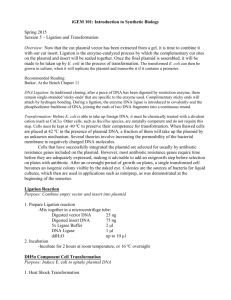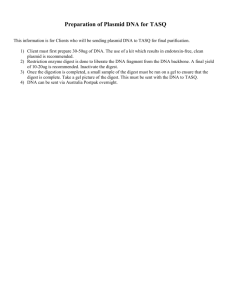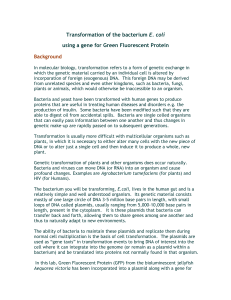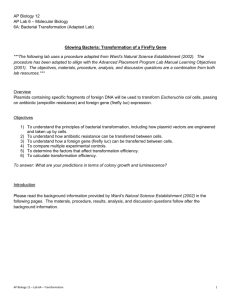Amgen Lab Study Guide
advertisement
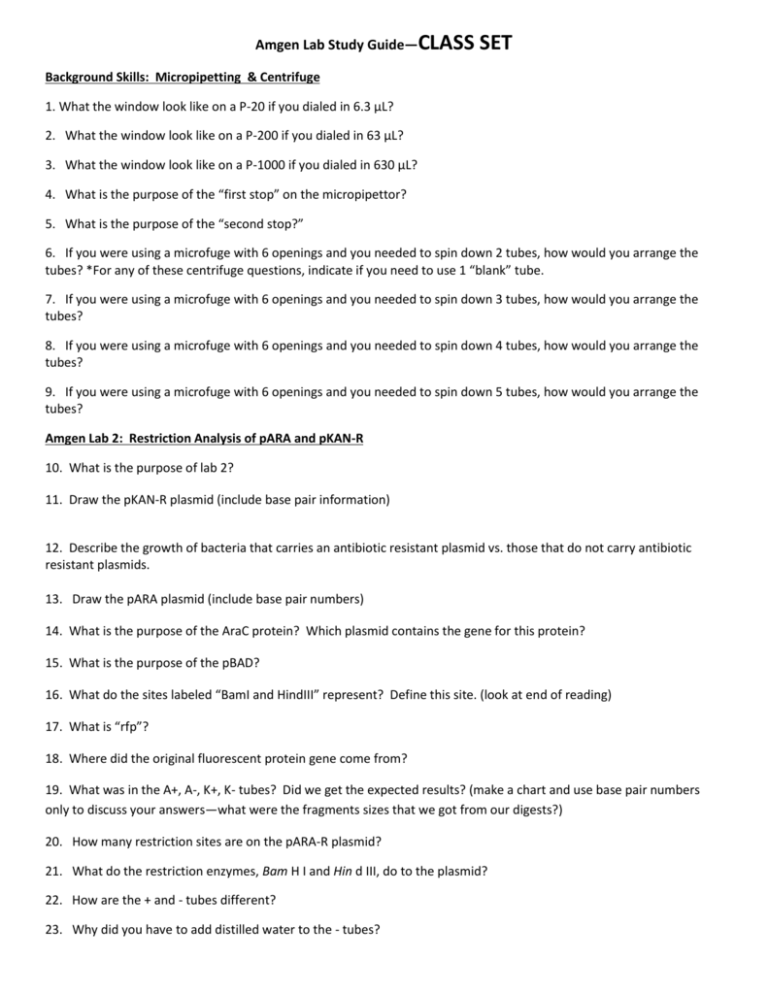
Amgen Lab Study Guide—CLASS SET Background Skills: Micropipetting & Centrifuge 1. What the window look like on a P-20 if you dialed in 6.3 µL? 2. What the window look like on a P-200 if you dialed in 63 µL? 3. What the window look like on a P-1000 if you dialed in 630 µL? 4. What is the purpose of the “first stop” on the micropipettor? 5. What is the purpose of the “second stop?” 6. If you were using a microfuge with 6 openings and you needed to spin down 2 tubes, how would you arrange the tubes? *For any of these centrifuge questions, indicate if you need to use 1 “blank” tube. 7. If you were using a microfuge with 6 openings and you needed to spin down 3 tubes, how would you arrange the tubes? 8. If you were using a microfuge with 6 openings and you needed to spin down 4 tubes, how would you arrange the tubes? 9. If you were using a microfuge with 6 openings and you needed to spin down 5 tubes, how would you arrange the tubes? Amgen Lab 2: Restriction Analysis of pARA and pKAN-R 10. What is the purpose of lab 2? 11. Draw the pKAN-R plasmid (include base pair information) 12. Describe the growth of bacteria that carries an antibiotic resistant plasmid vs. those that do not carry antibiotic resistant plasmids. 13. Draw the pARA plasmid (include base pair numbers) 14. What is the purpose of the AraC protein? Which plasmid contains the gene for this protein? 15. What is the purpose of the pBAD? 16. What do the sites labeled “BamI and HindIII” represent? Define this site. (look at end of reading) 17. What is “rfp”? 18. Where did the original fluorescent protein gene come from? 19. What was in the A+, A-, K+, K- tubes? Did we get the expected results? (make a chart and use base pair numbers only to discuss your answers—what were the fragments sizes that we got from our digests?) 20. How many restriction sites are on the pARA-R plasmid? 21. What do the restriction enzymes, Bam H I and Hin d III, do to the plasmid? 22. How are the + and - tubes different? 23. Why did you have to add distilled water to the - tubes? 24. What was happening in the 37ºC water bath? Amgen Lab 3: Ligation of pARA/pKAN-R Restriction Fragments 25. Define recombinant DNA. 26. Draw and label the pARA-R plasmid. Also, describe the function of the following areas: -rfp -PBAD -araC ampr 27. Briefly describe the process of DNA replication. 28. What was the function of DNA ligase in this experiment? 29. What are “sticky ends”? 30. Why will this new plasmid be able to express the mFP protein? (THIS IS IMPORTANT) 31. What are the roles of hydrogen bonds and phosphodiester bonds in the structure of DNA? 32. Describe in detail the role of DNA ligase. Discuss strength of bonds. Amgen Lab 4: Confirmation of Restriction & Ligation 33. What was the purpose of lab 4? 34. DNA has a negative charge due to the _____________. 35. Describe how various sizes of DNA fragments will move through an agarose gel. (explain in detail) 36. Why did the undigested plasmid lanes produce two or three bands? 37. What is the difference between a supercoil, multimer, and nicked circle? 38. Draw a gel and label these plasmid forms in the correct location as they move through the gel. 39. Summarize your gel results. What were loaded into the lanes and what were your results? (draw your lanes and draw in the bands – label these bands –use base pair numbers) 40. What is the purpose of the loading dye? What was in the loading dye? 41. What stain was used to visualize the DNA? (I did this portion of the lab) 42. Describe how you prepared your agarose gel. Make bullets and describe what you did…include the calculation used to prepare your 1% gel. 43. Describe how you prepared your 1X SB buffer. 44. Gel electrophoresis separates molecules based on what properties? 45. What is the purpose of “marker”/DNA ladder? 46. Why was DNA loaded into the negative end of the gel electrophoresis box? Amgen Lab 5: Transformation of E. coli 47. What is the purpose of Lab 5? 48. Why is the pARA plasmid now called pARA-R? 49. Define transformation. 50. To determine the extent to which you genetically transformed E. coli cells we must do some math. This quantitative measurement is referred to as the transformation efficiency. The transformation efficiency gives you an indication of how effective you were in your DNA of interest into bacterial cells. Transformation efficiency is a number. It represents the total number of bacterial cells that express the protein of interest, divided by the amount of DNA used in the experiment. A) Calculate the transformation efficiency of the agar plate below that was spread with 0.0569 g of plasmid DNA. Show all work. B) If plate#1 was spread with 0.065 g and had 200 colony forming units on it, and plate#2 was spread with 0.085 g and had 250 colony forming units on it, which one has higher transformation efficiency? EXPLAIN. Don’t forget to use scientific notation in your answer. (critical thinking question) Transformation efficiency = Total number of cells growing on the agar plate (in cfu) Amount of DNA spread on the agar plate (in g) Since Transformation efficiency is involves very large numbers, it is expressed in scientific notation. Be sure to express your answers in scientific notation with a unit of cfu/ g (colony forming units per microgram) 51. Define transformation efficiency? 52. What does it mean that the E. coli bacteria is “competent” (aka: it is a competent cell). 53. How do you prepare “competent” cells in the laboratory? Explain in detail! 54. Why do we need to “heat shock” the bacteria? Explain in detail! 55. Describe the your results for the LB agar, LB/Amp, and LB/Amp/Ara plates? (make a chart for each plate and describe the growth; include colony counts if any were taken) 56. What is the purpose of “heat-shock?” 57. Explain the relationship between PBAD, araC protein, arabinose, and transcription of rfp. 58. Why did E. coli grow on both the P- and P+ sides of the LB plate? 59. Why did E. coli only grow on the P+ side of the LB/amp plate? 60) Why are the colonies red on the LB/amp/ara plate but not on the LB/amp plate? 61) What is the formula used to calculate transformation efficiency? (include units)


